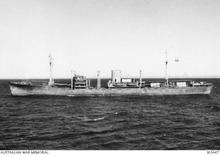Beam 48 ft 2 in (14.7 m) Launched 1930 | Tonnage 3,323 GRT Draft 20 ft 5 in (6.2 m) Length 98 m | |
 | ||
Name SS Japara1958 Davric1963 Phoenix1966 East Head1967 Arrow Head1968 Moji Trader1969 Victory | ||
SS Japara was a freighter built by Mach. Fabr. & Scheepswerf P. Smit Jr., Rotterdam in 1938, of 3,323 GRT and operated by Koninklijke Paketvaart-Maatschappij (KPM) in the Dutch East Indies trade.
Contents
World War II
Japara was one of twenty-one KPM vessels that took refuge in Australian ports after the fall of Java that Dutch officials requested be put into service for the war effort. The ship, among others, was chartered by the Chief Quartermaster, U.S. Army Forces in Australia (USAFIA) on 26 March 1942 with long term details to be negotiated at higher levels to become part of the U.S. Army's local fleet crewed by its KPM officers and men with an Army local fleet number of X-18 being assigned until released from the fleet May 1945.
Japara and SS Van Heemskerk escorted by HMAS Arunta were due in Milne Bay on the evening of 11 September, days after the surface raid that had sunk MV Anshun, when reports of another possible surface raid developing caused the convoy to hold until the morning of 12 September when it entered Milne Bay at about six in the morning. The transports finished unloading and departed for Townsville under escort of Arunta and HMAS Stuart on 15 September.
Logistical support of Allied offensive operations on the north coast of New Guinea by sea required establishment of a port west of Milne Bay at Oro Bay and a route by which large ships could pass through the largely uncharted and hazardous waters between. Small vessels transporting supplies in the early stages and survey vessels found that route and convoys code named Operation Lilliput were put into place to run two large ships under escort of one or two corvettes to Oro Bay in what were termed "flights" and given numbers. Japara was in a convoy of nine ships that departed Townsville 15 November 1942 that split on 17 November into a contingent going to Port Moresby and four, Japara, Balikpapan, Bantam and J. B. Ashe under escort of corvettes headed to Milne Bay with the three Dutch ships to become the first "flights" of Lilliput.
Japara, escorted by HMAS Lithgow, departed Oro Bay on 18 December on the voyage starting Operation Lilliput transporting U.S. Army port and engineer troops from Gili Gili at Milne Bay to Oro Bay that were to establish a functioning port and to construct a road from that shipping terminus to the new airfields at Dobodura which would make it possible to support and base bombers and fighters north of the Owen Stanley Range. The ship arrived with the troops, 750 tons of cargo, Australian pontoon barges to form a new docking facility and the Commander, Combined Operational Service Command (COSC) detachment for Oro Bay that would operate the growing port on the night of 19 December and was unloaded and away from danger by daylight. Japara returned to Oro Bay on the night of 26 December with the remainder of the U.S. troops to operate the port and build the Dobodura road and a troop of Stuart light tanks to supplement those arriving earlier in Karsik and two brought in by Bantam on 23 December.
Fate
Japara was sold in 1958 to Wheelock & Marden & Co., Panama and renamed Davric. She was sold in 1963 renamed Phoenix, sold in 1966 renamed East Head, sold in 1967 renamed Arrow Head, sold in 1968 renamed Moji Trader and lastly sold in 1969 and renamed Victory which was scrapped in Hong Kong in 1969.
